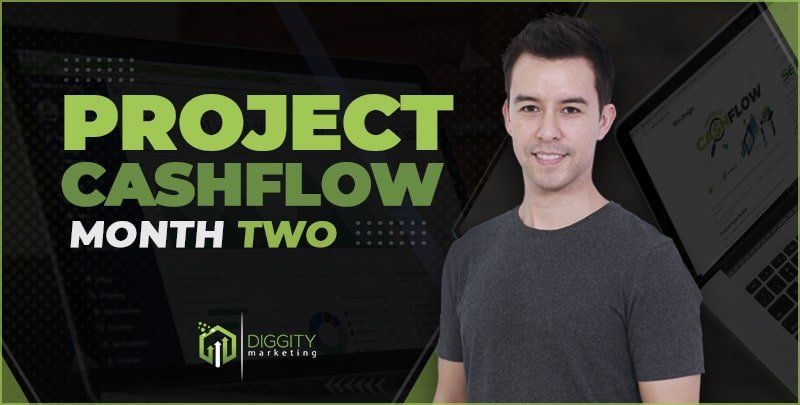If you’re like me, once you start building a new affiliate website or acquire an existing one, you do everything in your power to put the site in a position to succeed as fast as possible.
You might even call it a healthy obsession…
So last month’s case study was a monster — covering everything from the complete redesign of Project Cashflow to technical SEO, new content and content optimization, and our step-by-step process for hiring writers.
Project Cashflow Month Two is more about the incremental steps our team is taking to reach page one.
You’ll learn how I approach:
Optimizing existing content for search and for conversion
Creating new content to drive more traffic to your main money pages
The value of patience when doing link building outreach in-house
The link building power of expert roundups
The 301 redirect link building method
Turning the fallout from Google’s December core update into new opportunities
Roll up your sleeves — and let’s get to work.
We began the process of optimizing the existing content on Project Cashflow last month, but this month we took it further.
Many of the content revisions we made this month were as much to do with CRO as SEO.
Our content editor sharpened and polished the writing on existing pages.
Grammar and readability — Poor grammar and spelling mistakes are a red flag to users on almost any site. Given that Project Cashflow operates in the education niche, any grammatical errors are a particularly bad look. We also ensured that the readability level was appropriate to our target audience.
Fluffy intros — Get straight to the point of the piece.
Overtly “salesy” language — As with any affiliate site, the ultimate goal is to induce the reader to make a purchase. However, Project Cashflow is positioned as an objective source of information and unbiased reviews. Is your target audience meant to regard your affiliate site as an impartial resource? If so, content that’s pushy or aggressively trying to sell a product is far more likely to scare off a potential customer than seal the deal.
From a more technical perspective, we plugged each individual post into Surfer’s content editor to make sure each page was optimized for single keywords and phrases as per Surfer’s suggestions.
Replacing Content and 301s
Some content just isn’t worth saving…
When no amount of editorial triage can rescue a badly written piece with poor content flow, you’re better off just cutting your losses and moving on.
With Project Cashflow, two primary pages related to our main affiliate offer were comatose — practically invisible in the SERPs.
So we pulled the plug and wrote entirely new content for each page.
If you’re creating content for pages that are deadweight, take the opportunity to optimize the URLs for the target keywords…
Then set up 301 redirects to the new URLs, where you publish the fresh content for each topic.
Google has yet to “recognize” Project Cashflow’s new URLs as yet, but it’s just a matter of time.
Subtopics and Subheadings
Next, we took a closer look at subtopics and subheadings on each page on the website — H2s and H3s.
H2 and H3 subheadings heavily influence Google’s determination of how well you’ve answered a search query.
-
Competitor analysis: Make a list of all the headings and subheadings for the pages ranked 1-3 in the SERPs for your target keyword. Create a superset of headings derived from the top 3 to help ensure Google sees that you’re answering the query as well or better than the highest-ranking pages.
People also search for and Related searches: Found at the bottom of most SERPs, both fields are a goldmine for coming up with relevant subtopics.
People also ask: Google’s People Also Ask snippet in the SERPs is a rich source for subtopic ideas and inspiration for new articles.
People Also Ask also gives you a blueprint to create an FAQ section at the bottom of important pages — especially for long-form content. This can help you generate additional traffic for related long-tail keywords.

People Also Ask also gives you a blueprint to create an FAQ section at the bottom of important pages — especially for long-form content. This can help you generate additional traffic for related long-tail keywords.
The overarching goal of this process is to have the most comprehensive piece of content for the target keywords you’re trying to rank for — and to structure the article so that Google recognizes it as the best resource.
Even if you publish the most well-written and exhaustive post targeting a keyword, that often isn’t enough to rank unless you structure it in a way that Google understands.
New Content
Since Month One, we published 15 new articles on Project Cashflow — all of them targeted and building topical relevance for our main keyword.
The ultimate goal of these new articles is to drive more traffic and higher rankings for our most lucrative affiliate offering.
Versus keywords are keywords that compare two related but different and typically competing products.
For example: Windows vs. Mac OS, Thrive Architect vs. Elementor, Paleo vs. Keto, etc.
They already have some knowledge about the product they’re thinking about purchasing, and they’re at the “comparison shopping” stage, hunting for the best option.
Answer the Public and AlsoAsked can be useful tools when trying to surface versus keywords.
Round It Up
No doubt you’re intimately familiar with that staple of any content marketer’s diet — the expert roundup.
Link Building — A primary incentive for experts to contribute to a roundup is that they receive a dofollow link back to their homepage or another page of their choice. While there are exceptions, it’s commonplace for contributors to link back to your site in return. This may occasionally be negotiated in advance, but typically you just hope they’ll link to the roundup from their site.
Social Sharing and Social Proof — Contributors are almost always happy to share roundup posts through their social media channels, driving more traffic to your site and helping build social proof.
Increased Brand Authority: Having legitimate experts contributing to your site lends authority to your brand and makes your other content appear more credible.
“Free” Content — If you create your roundup post in-house, there’s little need for a writer. Aside from contributor outreach, a short intro, editing, and formatting, the result can be long-form, authoritative content that the experts typically write for free.
Our content team at LeadSpring often produces roundup posts for our portfolio of affiliate sites, but for the first Project Cashflow roundup post, we decided to outsource…
I hired Minuca Elena — an SEO who specializes in expert roundups.
Minuca handles every aspect of creating a roundup post. Typically, this includes outreach and follow-up with relevant experts, influencers, and bloggers — as well as content creation.
The end product is a finished roundup post, ready for you to publish on your site.
Whether you create them yourself or opt to outsource, roundup posts are certainly worth a look as part of your content creation and link building strategy.
Link Building
Last month, we kicked off our link building campaign for Project Cashflow with 12 guest post links from Authority Builders.
At the same time, our link building team got started on scraping contacts and began email outreach for link insertion opportunities.
Doing your link building in-house has both advantages and disadvantages…
Purchasing guest posts from a reliable vendor is painless and virtually instantaneous…
That’s a big part of the reason why we kick-started our link velocity for Project Cashflow right away with guest posts from Authority Builders.
But guest posts are only one component of my link building strategy…
If you want to want to explore every avenue for building new links, you owe it to yourself to consider link insertions.
Depending on the number of backlinks you’re looking to source it might also make sense for you to bring a dedicated link builder on board..
Of course, you can do it yourself, but outreach for link building is a ton of work and difficult to scale on your own.
For Project Cashflow, it took almost a month for our link building team to compile contacts, create email templates, and begin landing link insertion opportunities.
All that hard work has just started to pay off — here are our results for December from in-house link building:
11 link insertions
1 link exchange
1 link from broken link building
As always, link juice takes some time to flow with Google, but we’re expecting a decent jump in next month’s rankings thanks to our team’s efforts.
The 301 Acquisition Method
One new link building tactic we put in place this month, that I hope to have a positive long term SEO impact, was acquiring an existing, aged domain in the same niche as Project Cashflow.
Once purchased, we used a 301 redirect to send all of the domain’s traffic and existing backlinks to Project Cashflow…
301 redirects are primarily intended to be used when a website, or a page on the site, permanently moves to a new URL.
But 301s also have many SEO applications — including passing link equity and traffic from one domain to another.
Historically, experts believed that 301 redirects resulted in a +/- 15% drop in PageRank — which is still a crucial ranking factor.
However, in 2016, Google stated that 301s no longer cause any loss in PageRank.
In theory, this means you can pass along most — even all — of the existing link juice from pages on a site you acquire to pages on your money site.
The ability to redirect backlink authority from an aged domain is what makes 301 redirects attractive as a potentially powerful ranking tool…
But as with virtually any SEO tactic, you need to approach 301 redirects from a site you’ve acquired with caution. .
The jury’s still out on whether the approach I’ve taken with this 301 acquisition for Project Cashflow will move the needle…
But you’re about to find out exactly how I did it step-by-step…
1. Finding the Right Aged Domain
You can search for aged domains on auction sites or use resources like Sean Markey’s SEM Newsletter…
But hunting down a domain with authority relevant to your micro-niche using these methods can take a very long time.
Since my goal is to rank Project Cashflow as quickly as possible, I turned to a new source: ODYS GLOBAL.
I invited ODYS founder Alex Drew to share some info about the service with you:
“ODYS GLOBAL provides premium/brandable aged domains with substantial organic SEO authority.
We don’t invest in domains just because they have a ‘cool’ name — unless the site also has powerful, well-vetted organic backlinks (and, in most cases, traffic.)
ODYS also doesn’t offer domains just for the sake of SEO — think ‘abc-congress-world2016.org’ — no matter how sparkling clean and high-authority the link profile.
ODYS domains are primarily intended for startups and online business ventures looking for a branded domain with SEO authority already in place.
But many clients also acquire ODYS domains to take advantage of existing backlinks, trust, authority, and traffic using the 301 acquisition method.”
ODYS Global Founder
2. Purchased the Niche-Relevant Aged Domain from ODYS
ODYS was able to help us source an aged domain from their inventory that was highly relevant to Project Cashflow’s niche.
When you acquire a site from ODYS it’s live and hosted long before you even make the purchase. That means the domain was pretty much good to go for use as either a money site or (in our case) for a 301 redirect to the relevant page on Project Cashflow.
3. Published a Dedicated Page on Project Cashflow for the 301 Redirect
Rather than redirecting the ODYS domain to Project Cashflow’s homepage or one of our money pages, we created a dedicated “acquisition page” on Project Cashflow describing the merger of the two “companies.”
The content on the acquisition page focuses on why combining the two sites means a better experience for our potential audience. We also summarized the history and original mission of the domain acquired from ODYS.
We built internal links from the acquisition page to our top 3 money pages on Project Cashflow to try to pass along link juice from the ODYS site. We also linked to the acquisition page from our About Us page.
By taking this approach, our goal is to make the acquisition look as “natural” as any business buying another company in the same industry. While at the same time, passing along as much link juice as possible from the ODYS site.
4. 301’ing the Odys Domain Using a Wildcard Redirect
If you’re moving a site you already own to a new domain, the easiest and most common way to permanently redirect your traffic and authority is at the domain level.
Typically, this is easily accomplished by making the change yourself in the control panel of your domain registrar (GoDaddy, Google Domains, Namecheap etc.)
But there’s more than one way to do it…
From a technical perspective, you can deliver the same effect as a domain-level 301 at the hosting level or even the CDN-level if the site you wish to redirect has one in place.
That’s exactly what I did…
The ODYS site and all its pages were redirected to the Project Cashflow acquisition page through Cloudlflare — the ODYS site’s CDN.
To accomplish this, we used a wildcard 301 redirect.
With a wildcard 301 redirect, every single page on the ODYS site is redirected to the acquisition page on Project Cashflow.
But it’s not always something you should do after acquiring an aged site for link building purposes.
With this particular ODYS domain, the vast majority of external links went to the homepage.
If individual pages on the ODYS site had a significant number of backlinks, it would have been worth recreating the old pages on Project Cashflow with similar content.
In this case, no pages other than the homepage had enough backlinks to make it worth the effort.
The 301 wildcard redirect went into effect at the beginning of January. Typically, it takes a minimum of 30 days for any SEO benefits from the 301 to kick in…
So we haven’t seen any impact from the acquisition just yet, but (fingers crossed), I’ll have some good news to share with you next month.
Are there any risks to using the 301 acquisition method?
Sure, there are risks associated with any grey-hat SEO tactic.
We weighed up the pros and cons and decided that the link juice was worth the squeeze.
Paid Links
Typically we acquire any backlinks we don’t build in-house from Authority Builders.
But with a micro-niche site like Project Cashflow, you’re sometimes better off buying additional links from a specialized supplier.
We sourced a vendor that specializes in the education niche and purchased two high-powered EDU links from two different websites with an Ahrefs Domain Rating of 80+.
For both links, we used niche-specific target anchor text directed to our top money page.
Google indexed both links right at the end of 2020 and now we’re waiting to see what impact they have on our rankings.
In Project Cashflow Month Zero, I shared the fact that the whole reason I acquired a site in the education niche in the first place was because of a hot tip on a lucrative affiliate program from one of our affiliate managers.
That offer is Project Cashflow’s primary focus, but you always want to add as many relevant revenue streams as possible.
As you may have discovered yourself, that can be easier said than done.
When conducting a competitor analysis, one of the many things I look at is what affiliate programs the websites ranking on page one for our target keywords are participating in.
In the case of Project Cashflow, there are numerous affiliate products promoted by competing websites that are highly relevant to our microniche…
So, of course, we’d like to add them to our offering.
But getting these programs to respond to email and phone calls requesting to sign Project Cashflow up has been like banging our heads against the wall.
If you’ve ever found yourself in this predicament, I wish I could say I had a solution for you other than “be persistent.”
For Project Cashflow, we’re waiting for when we have more traffic and leverage in the niche before making a more concerted effort to pursue the affiliate programs that have been unresponsive.
E-A-T and CRO
Last month, you learned in great detail about how we boost E-A-T by taking steps to make an affiliate site appear more like a “real” business.
In Month Two, we made further changes that should help futureproof Project Cashflow against algorithm changes that give more weight to E-A-T in the future…
But right now, those changes are more about CRO.
E-A-T is another area where there is a massive overlap between CRO and SEO…
Not only do measures you take to build your site’s authority and trust potentially help your site with Google, but they also help give potential customers faith in your business.
In Month Two, we made significant changes to Project Cashflow’s About Page.
While I don’t expect this to pay any immediate SEO dividends, it can help instill trust in potential customers.
The original About Page was literally just what the site was about:
Types of products the site reviews
What software the site analyzes
Background on the niche
Mission statement
What kind of person we seek to help and why
The problems Project Cashflow solves for readers by providing unbiased reviews and other resources
The original About Page made it abundantly clear that Project Cashflow was nothing but an affiliate “money” site.
The new About Page emphasizes the site’s authority and benefit to the user.
Site Design
After last month’s complete site redesign, we only made a few additional — but substantial — changes to Project Cashflow’s design:
Repaired and augmented search functionality
Eliminated unnecessary sidebar navigation from pages where the nav added no value — such as category, About, search and search result pages
Improved product categorization
Redesigned the business logo
Impact of the December Core Update
Like everyone else, I’m still trying to figure out exactly what changed with Google’s December core update…
But we did see at least one benefit.
Three of our secondary product categories — each of which only had one or two pages devoted to them — jumped in the rankings by 20 to 40 positions.
Unfortunately, these categories are unrelated to our main money-making affiliate offer…
But why pass up an opportunity to drive additional revenue??
We immediately began creating additional content for each of the three categories, which might lead to a nice supplemental income stream.
Given that Project Cashflow is in the education niche, it’s little surprise that organic traffic remained static in December and even dipped a bit during the holiday season.
People are probably more concerned with taking time off and relaxing during the holidays than hunting for products in Project Cashflow’s niche.
But we’ve seen a nice uptick in traffic since the beginning of 2021 — maybe Project Cashflow’s audience’s New Year’s resolutions are kicking in.
As for revenue, Project Cashflow was only monetized during December 2019 — so a year- over-year comparison is fairly meaningless:
Amazon Revenue December 2019: $12
Amazon Revenue December 2020: $266.08
Non-Amazon Affiliate Revenue December 2020: $77.50
As you’ll recall from previous installments of Project Cashflow, new non-Amazon affiliate offers are the primary reason I acquired the site in the first place…
We’ll be looking for a significant increase in revenue from the new offering in 2021.
Based on the historic seasonality of earnings in the niche, sales start to ramp up in March and our big months are likely to be May and June.
Hopefully, good timing for all our SEO efforts to start bearing more fruit.
Final Thoughts
Project Cashflow Month Two’s biggest takeaway is that SEO is a game of patience — for everyone.
Even leveraging LeadSpring’s extensive resources and expertise doesn’t guarantee rank boners overnight.
The links you build today and the on-page SEO you toil away at can take months to reflect in the rankings.
In the meantime, I suggest you follow my SEO motto: Do all the things.
If you want to learn exactly what I mean by that and how I approach affiliate SEO step-by-step, check out The Affiliate Lab.
And watch out for next month’s installment of Project Cashflow…
Join us on our march towards page one.
Got Questions or Comments?
This content was originally published here.





 Optimizing existing content for search and for conversion
Optimizing existing content for search and for conversion